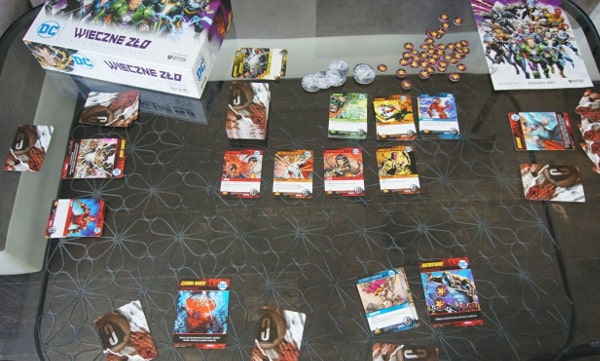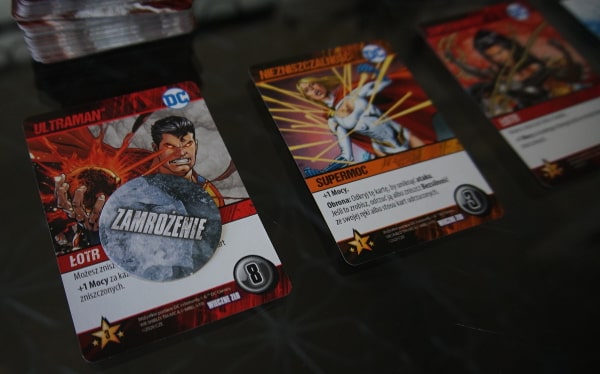
Eternal evil cannot be compared to the previous game Superhero Duelfrom the same creators (engine developed by Matt Hyra and Ben Stoll). The games are almost identical. The main difference is that this time we play as villains, not heroes, to defeat Superheroes instead of Super Villains. The idea itself is therefore not very original. Even looking at the box – I know I’ve seen it somewhere. The game is exactly the same: we build up our decks to get as many victory points as possible. We start with quite weak Hit cards, then we buy Kicks and stronger and stronger Equipment, Superpowers and other goodies. In the meantime, we break the pile of our biggest opponents, in this case Superheroes. The game ends when we defeat them all or the main deck is exhausted. The surprise here are the extra victory points in the form of tokens and of course the new themes taken from the seriesEternal Evil Geoff Johnes and illustrators Richard Friend and David Finch.

Inspired by the Eternal Evil comic book series
Among the Location cards we will find “Earth-three”, where the main action of the comics takes place, where the mysterious newcomers, deceptively resembling members of the Justice League, smashed its original composition, killing most of the Superheroes and taking their place; and “Happy Harbor” with an overturned superhero tower, which has now become the seat of the villains gathered by the visitors, the so-called Crime Syndicate. In the main deck of cards, of course, we will find the new “evil counterparts” of the Justice League, i.e. Ultraman, Superwoman, Owlman, Power Ring, Johnny Quick and the Atomic, and a lot of other themes related to this world.
We play the well-known characters from DC Comics, such as Lex Luthor, Harley Quinn, Deathstroke or Sinestro. Each of them has its own individual property that we can constantly use. Interestingly, some of them combine perfectly with thematically linked cards, e.g. when playing Bizarro, we will not hesitate to take Bizarro’s Power into our hand, which other players definitely avoid.

In the game, the Justice League is still alive and our task is to destroy it (we have to kill Flash, Batman, Superman, Aquaman or Green Arrow) and defeat a few other Superheroes such as Constantine, Martian Hunter, Cyborg, Shazam! or the Swamp Monster.
The graphics of the basic cards of Blows, Helplessness, Kicks and Weakness have also changed to suit the new atmosphere. This is, of course, only a cosmetic change.

What’s new since the Superhero Duel ?
In addition to the changes in the graphic design, the aforementioned victory point tokens and freezing tokens appeared from the novelties. In addition, we perform actions of destroying cards much more often and their pile began to play an important role in the game. Victory points in the form of tokens differ from those on cards in that it is much easier to lose them (e.g. when Constantine attacks us, he takes three such points from each player), but you can also steal them from your opponents using Catwoman’s attack. The Rogues expansion significantly expands their use, which you will read more about later in this text.
Freezing tokens are, for me, a definite excess of form over content. They are used only by the Freezing Pistol, which allows us to reserve the card in the bank for the next turn. I haven’t used this action very often and I think that we could mark frozen cards in some other way, e.g. by placing them sideways.
As befits evil, we have plenty of destruction in Eternal Evil ! Starting with removing disposable cards such as Steve Trevor, Word of Power and Emperor Penguin, eliminating positions from the bank, which the Justice League bad doubles allow, or getting rid of those on your own or your discard pile, for example via Messenger, Transfiguration or Superintellect, even ending with weakening the deck of opponents with the use of Broadsword.

These activities make player turns much longer, especially later in the game, when the decks are already very large and it takes a lot of time to browse through the cards. So why are we doing this?
Of course, it is important to undermine the power of the opponents and to get rid of cards with negative points and poor positions from your own deck, which would weaken your hand. Additionally, while in possession of Deathstroke, we will get as much as ten points at the end of the game, if we limit the size of our deck to only twenty positions. The same is true for the Spectral Visitor, for whom we remove all zero cost cards.
When playing Superwoman, Power Ring, Owlman or Ultraman, we not only rob the bank out of pure malice (although this would also fit the plot of the game), our goal is to have as many elements of a specific type as possible in the pile of destroyed cards (e.g. Inventories, Superpowers, Heroes) which will then give us more power points. We also use selected types, for example, with Superman or Batman.
In practice, it is more convenient to immediately spread the destroyed cards into several separate piles, which takes up more space on the table, but gives more transparency.

